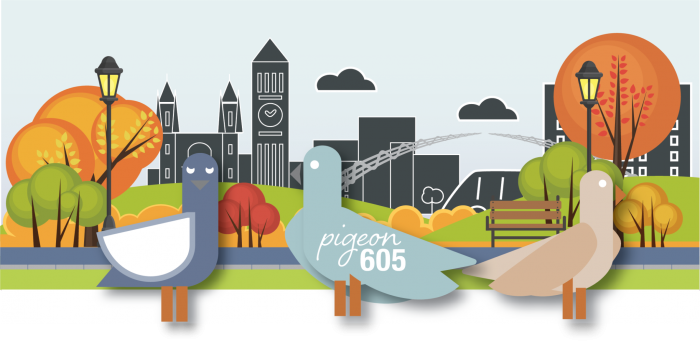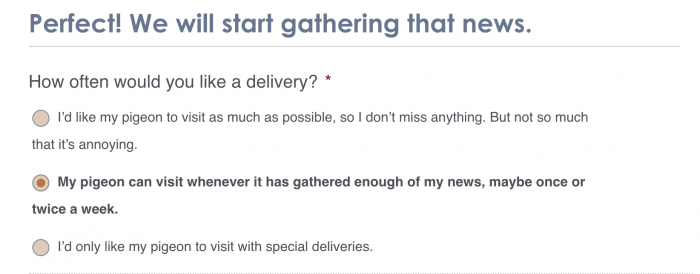
Here’s a fun one. Did you know Paul Reuter, who would go on to found Reuters, initially used pigeons to fly stock prices and other bits of news between Aachen and Brussels?
In South Dakota, Pigeon 605 — a year-old sister site to SiouxFalls.Business — is delivering personalized local news with a modern-day fleet … minus the feathers. (The “605” refers to the area code that serves the entire state.) In a city that just crested 200,000 residents, more than 4,000 people have picked a virtual pigeon to deliver news based on their interests and neighborhood.
Here’s how it works. Choose (“adopt”) a bird, decide on a name, and tell Pigeon 605 what news stories you’re interested in. (In addition to topic-specific news stories, readers can also opt-in to categories like “Stories that will make me smile, laugh, or maybe cry,” “Stories that are a little quirky,” and “Stories that will make me a more informed citizen.”) You determine how often you want to hear from your virtual bird.

I chose a grumpy-faced gray one and named him after the little birdie who told me about Pigeon 605. In the past week or so, I’ve gotten a text message and a handful of emails, including one that sought to balance tough Covid-19 news with a missing cat story.

Pigeon 605 is profitable, said founder Jodi Schwan. The local news site has taken flight thanks to advertising and, in particular, sponsored stories. (Schwan owns Align Content Studio, the publisher of both Pigeon 605 and SiouxFalls.Business, and the two-person team employs a number of freelancer reporters and photographers for the outlets.) The partner stories sponsored by nonprofits, corporations, and local businesses are labeled and Pigeon 605 promises its readers it will not accept political advertising.
Schwan got her start in broadcast journalism (at the local KELO-TV) and oversaw the digital transformation at the Gannett-owned Sioux Falls Business Journal before striking out on her own with SiouxFalls.Business in 2017. That site focuses on development, entrepreneurship, and local industries including healthcare and manufacturing.
“I became fairly convinced that I wasn’t going to retire at a newspaper. I wanted to be in a place that was in a position for growth — and particularly in a position to add staff and not cut staff,” Schwan said. “And so I started thinking about what that might look like.”
Although neither SiouxFalls.Business nor Pigeon 605 has a reader revenue model, Schwan said she’s considering adding elements of one to help diversify the way she funds the digital news sites.
The pandemic made the launch of Pigeon 605 feel like “a year-long soft launch” at times, Schwan admitted. (“Scheduled and rescheduled: Your guide to 2022 concerts in Sioux Falls” currently sits on the homepage.) Their audience is growing steadily but the site is still experimenting to find the right mix of coverage.
“I didn’t want to come in with something that looked like what everybody else was doing,” Schwan said. “I didn’t start out covering crime and politics and weather. I went a different direction. I went where I thought there would be community interest, but also to places that would allow us to stand out.”
Schwan sees personalization and innovative delivery methods — including texting, where she has seen readers consistently and enthusiastically engage — as the future of local news. The quick survey that readers complete as they “adopt” their pigeon gives her insights into her audience, and provides a road map for moving ahead.
“The big goal is to have more people adopt because the more we grow that database, the more interesting things we can do,” Schwan said. In the future, she hopes to expand stories that help locals be “informed citizens,” add more school-specific coverage — possibly by partnering with students themselves to publish stories — and offer more localized content.
“Sioux Falls is just beginning to develop its metro area communities, what you would typically consider suburbs, and a lot of them are underserved from a news perspective,” Schwan said. “As they grow, I love the idea of being able to send news to specific zip codes or specific communities.”
I have to say: A little personalization goes a long way. I’ve never set foot in South Dakota, but I’m still opening all of my missives from “my” pigeon.
“I think the data is key here when you look at the business case for this, but hopefully, it’s the brand and the user experience that keeps readers coming back,” Schwan said.